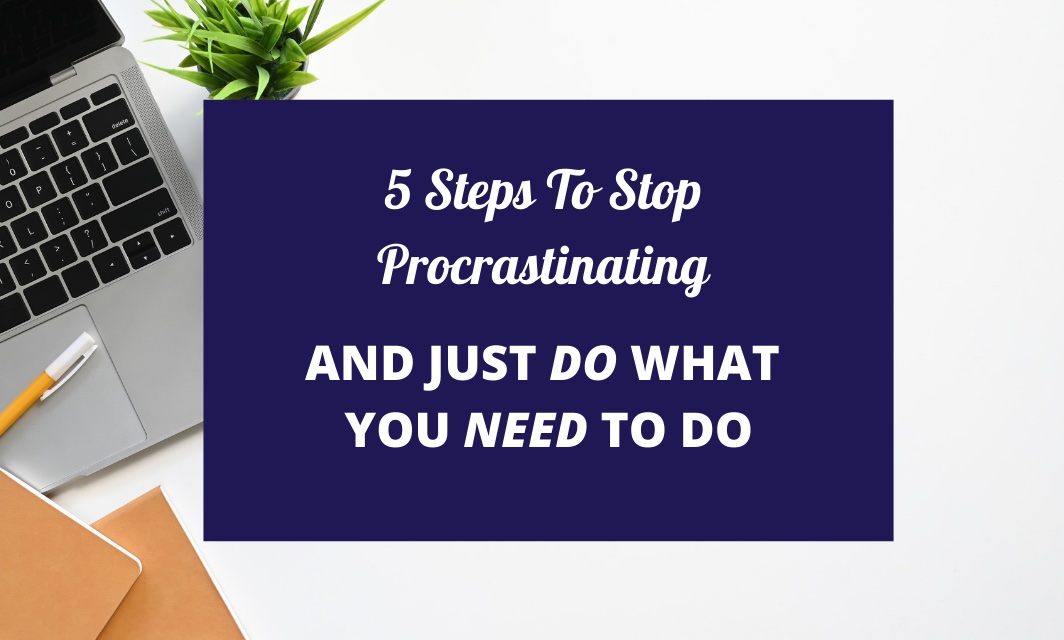“How do I stop procrastinating and force myself to do what I know needs to be done?”
That’s probably the biggest and most frequently asked question I hear.
Procrastinating is the single biggest factor that keeps women in business stuck, and it will prevent you from ever achieving the things you really want in life, if you let it.
One of the things I’ve become known for being really good at is getting stuff done – and now helping others to do the same.
I’ve learned to take serious, effective action as soon as an idea comes into my head and now have the ability to use those most important higher mental faculties of imagination and will, to implement like a boss!
And not only to start the task – but to work on it until it’s complete. Something I struggled with previously for decades.
So how do I do it?
Well, for me it has been a journey of mental re-programming – and one that I now take my clients through – but I’ve condensed my findings (and the systems I use myself) down into the 5-Steps below.
The first thing to understand is that there is a ‘procrastinating psychology’.
I often hear people say “ I just need to get out of my own way”, or “I’m the only thing stopping me” – as if it’s some conscious decision that they’re making not to do stuff.
But that’s not the case.
The truth is it’s your subconscious mind that’s holding you back – not your conscious mind.
Let me explain…
Paradigms – what are they and why do you need to change yours?

Paradigms sit in the subconscious part of your mind and are mental programmes that have almost exclusive control over your habitual behaviour. They are the “operating system” on which all your mental processes run and they have been created as a result, primarily, of things that have happened in your past.
The way you walk, the way you talk, the way you greet people, the way you stand, the beliefs you hold, the way you react in certain situations, how quickly you make decisions, how often you change your mind…
they’re all controlled by this ‘operating system’.
Your paradigms create the prism through which you view and make sense of the world around you.
When information is presented to your mind, your mind runs through all of the things it already knows about that piece of information. It figures out where it fits in with the bigger picture, and decides if the information is good or bad, desirable or undesirable, possible or not.
Paradigms in and of themselves are neutral. If your particular paradigms are positive, you will have a happy, growth-oriented life, a healthy self-image, and the ability to adapt successfully to changes, upsets, and unforeseen events.
Conversely, negative paradigms can keep you stuck in old ways of thinking that can be very limiting.
They keep you as imprisoned as do a cell and a set of iron bars. Maybe even more so, since they imprison you in the place where all true freedom resides: the mind.
Your Paradigm Sets Your Auto-Pilot

Paradigms act as a kind of auto-pilot. You see you’ve been set a certain course – and it’s your paradigm that has dialled in that heading.
Based on the things you were told as you were growing up, the things you heard said about you, things you heard said about other people, the beliefs your parents instilled in you, the desires they instilled in you, the things you watched on TV…
All these things went to make up your paradigm – the thing that controls your beliefs and your habitual behaviour. Your habitual behaviour is driving your results. And guess what?
96-98% of your behaviour is habitual.
So what does that mean and how does it lead to you procrastinating?
It means that you actually only have conscious control over 2-4% of your behaviour. The rest is all dealt with subconsciously by your paradigm.
So whenever you consciously consider doing (or actually try doing) something new that is out of alignment with your current auto-pilot setting, your subconscious paradigm kicks in, takes remediating action and brings you ‘back on course’
Just as an aeroplane’s auto-pilot would.
Which usually means it either preventing you taking certain actions or making you change back to old habits when you’re trying to build new ones.
Procrastinating is the process of your paradigm actively trying to stop you making changes.
Unless you change your paradigm, any changes to your behaviour will be, at best, temporary and procrastinating will continue to prevent you moving forward.
So how do you change your paradigm?
Well, there are two ways:
1. >> A significant negative emotional impact – e.g. a bereavement, a major terrorist event, a divorce, a global pandemic…
Big emotional impacts have the ability to completely change your paradigm forever – the things you believe, the way you see other people, the things you think are possible, the things you value…they can all be changed overnight in this way. (Think ‘9/11’ or ‘COVID-19’)
2. >> Constant, spaced repetition of ideas – obviously it is not ideal to try to use a huge negative emotional impact to help my clients change their paradigm, so we use the 2nd method which is continually and repeatedly exposing your paradigm (or subconscious mind) to the results you want to happen.
We use a number of different techniques to do this (usually over an extended period of time) and I have incorporated a few of these into the following 5 step process for you.
(And if you’d like more info about changing paradigms, you should join us for my next FREE 5-Day “Science Of Success” Quick-Start Challenge and let me help you in person! You can register now HERE.
‘Stop Procrastinating’ Step 1 - What do I really want and why?

Take some time to write out what it is you’re trying to achieve in this particular instance, and why.
And when I say write it out, I mean write it out.
Don’t just think about what you’d write – take an actual pen and an old-fashioned piece of A4 and write it out.
Why?
In our training, writing plays a huge part in re-programming how your mind works.
Writing out your goal forces you to think – really think – about what you want.
Thinking creates a feeling or emotion, and it’s this emotion that determines the actions you’ll take.
If what you’re trying to achieve doesn’t make you feel really good when you think about having achieved it you’re unlikely to take the actions you need to take to achieve it.
And if that’s the case, why are you wasting your precious time on it?
Resources:
https://www.emmahague.com/life-goal
‘Stop Procrastinating Step 2’ - What do I need to DO to achieve this?

Make a committed decision about what you’re going to do to solve this problem or achieve the results you want.
Choose a definite plan of action and lay it out. Literally ask yourself “What is the first thing I need to do to resolve this?” and write it down.
“Then once I’ve done that, what’s the next thing I’ll need to do?” and write it down.
“Then once that’s done, what’s the next thing I’ll need to do?” and so on.
In this way, you will create your own step-by-step process for achieving your goal or target.
So many people worry about the ‘how’.
Procrastinating is a symptom of worrying they’ll make the wrong decision on how to move forward, so they don’t make any decision at all and stay stuck.
If there are a number of ways you could move forward on this – pick one. Now.
You won’t know if it’s the ‘right’ one until you make a start and you can’t make changes to your plan until you make a start.
Maxwell Maltz said “A step in the wrong direction is better than staying on the spot all our life. Once you’re moving forward you can correct your course as you go. Your automatic guidance system cannot guide you when you’re standing still.”
‘Stop Procrastinating’ Step 3 - How do I break it down into do-able chunks?

You have to start taking focused, effective action in order to achieve anything in life.
And that means doing certain things, in a certain way, every day.
Breaking down the steps you have identified in your success system into smaller tasks is essential. Even if you’re not really sure on how to do something.
A task could be to research something or choose someone to follow on a particular subject or look up how someone else did something.
You have to start moving – telling yourself you don’t know where to start leads to your subconscious mind ‘not knowing where to start’.
Just start writing and see what comes.
Once you start to get some ideas, get into the habit of writing out 6 Goal Achieving Activities every evening and number them from 1 to 6.
These are activities focused purely on achieving the goal you set in Step 1.
You will start work on these 6 Goal Achieving Activities the next morning and you will not move on to number 2 on your list until you’ve completed number 1.
You won’t move on to number 3 on your list until you’ve completed number 2.
Taking action is the antedote to procrastinating.
Give Yourself Permission To Make Your Goal A Priority.
This is important.
One of the biggest reasons so few people actually achieve their goals is that ‘goals’ are never urgent. Ever.
There’s always something else we put first. You have to stop doing that.
Don’t worry about all the incidental things you have to do during the day – if they’re really important, they’ll get done.
If the kids need feeding, you’ll feed them. If the dog urgently needs walking you’ll walk him. If someone gets ill, you’ll go help them.
But you know, you’ll be surprised at how many of those incidental things that crop up and distract us during the day, really aren’t that urgent and can be done later.
‘Stop Procrastinating’ Step 4 - How do I find the time?

We all have 24 hours in a day. That’s it. We all have the same amount of time.
So why do some mums and dads with kids who work full time achieve the things they really want and some don’t?
Why do some divorcees and some widow/ers achieve the things they want and some don’t?
Why do some people who survive critical illnesses go on and achieve the things they want and some don’t?
Why do some people with medical conditions or physical disabilities achieve the things they want and some don’t?
You only have to browse YouTube for a few minutes nowadays to see all the ‘regular’ people who are striving to achieve more than they currently have.
There has never been a better time to create the life you actually want to be living.
And we all only have 24 hours in a day.
The truth is you can’t manage time. You can only manage yourself and what you do in the time you have.
There are so many tools and resources available for helping you manage your tasks but, at the end of the day, if you’re not prepared to take responsibility for your time, none of them will work.
Letting other people dictate how your day goes is one of the biggest mistakes I see.
You are responsible for your 24 hours and you are responsible for saying ‘No’ to other people – whether it’s your parents, grandparents, partner, children or boss.
Shelving your own plans at the drop of a hat to go off and see to someone else’s wishes is incredibly common and is another form of procrastinating.
One of my favourite chapters of any book is the ‘Persistence’ Chapter in Think And Grow Rich by Napoleon Hill and I find myself continually referring clients to the following passage:
Hill says “Countless numbers of men and women, both young and old, permit relatives to wreck their lives in the name of DUTY because they fear criticism. (Duty does not require anyone to submit to the destruction of one’s personal ambitions and the right to live one’s own life in one’s own way)”.
You don’t have to become some uncaring recluse but you do have to start taking control of your time.
One of the worksheets I give my clients is designed to identify the ‘leaks’ in their day.
You can do a similar thing by following these instructions:
Take a pad of paper and write down all of the different things that take up your time each and every day. Include every curricular and extracurricular activity. Be ruthless!
This is not the time to be forgiving – we’re looking for change, not excuses.
Once you’ve done this, underline or tick off all the things that can go for at least the next month, to give you the time and space to work on whatever it is you’re looking to achieve.
What can you ask another friend or relative to help with? What can you move so you do it last thing on an evening or first thing on a morning to clear your working day? What can you just get rid of altogether?
Then do it. Make a commitment to eliminate the things (for the short-term, remember it’s not forever) that eat up major amounts of time each day and week.
You can slowly start to add things back in when you feel like you’re making headway.
Remember: “A strong focus now creates a different future later.”
‘Stop Procrastinating’ Step 5 - How do I make sure I stick to it?

Now you’ve got clear on what you need to do, it’s imperative that you remind yourself constantly of what’s possible if you just do it!
Visual reminders are good (like a vision board, a goal card or even just a post-it-note with one word on it) and sticking them in multiple places – on your bathroom mirror, your car dashboard, next to the kettle etc. – is a great way to make sure that goal stays top of mind.
I like to write out how I’ll feel when I’ve accomplished my goal, however big or small it is, in the present tense.
For example: “I’m so happy and grateful now I have finished writing my book and am sharing my ideas with the world”, “I’m so happy and grateful now I have lost 2 stone in weight and feel confident and sexy in my holiday bikini”, “I’m so happy and grateful now I have de-cluttered and cleaned my office – I feel professional, organised and productive.”
It might feel a bit silly at first but believe me, writing out these kind of statements multiple times a day (I aim for 100 if I’m struggling to stay focused) or recording yourself saying the statement and playing it to yourself on loop during the day actually works wonders.
And there’s a science behind this kind of repetition.
Remember I spoke about your paradigm in the intro to this post and how important it is to change it?
This is the first step in re-programming that paradigm.
Actually imagining yourself achieving your goal (and, importantly, feeling that feeling of success) over and over again is the constant, spaced repetition of ideas that will lead to permanent change.
And finally…let go of what other people might think.
Fear of being ridiculed, embarrassed, disliked or thought of as being selfish or greedy will all hold you back and stop you doing what you know needs to be done.
And if that fear is bigger than your desire to achieve what you want to achieve, you’re on a hiding to nowhere.
So ask yourself…is it?
Resources:
‘Think & Grow Rich’ – Napoleon Hill And ‘The Science Of Getting Rich’ by Wallace D Wattles


Emma Hague is a Certified Proctor Gallagher Consultant and Real Results Mentor based in the U. K.
A qualified accountant by profession, Emma now teaches self-employed women (and some very lucky men!) over 40 in the UK, USA & Canada how to achieve their life-goals – no matter where they might be right now.
As a business owner for over 14 years, Emma believes passionately that we need to take control of (and responsibility for) our own lives in order to create the freedom we all want.
Away from her business, Emma is an avid rugby league fan and loves to spend time with her family (she is mum to two young girls and two grown-up step-sons).
She also enjoys running, beach holidays and going on city breaks with her husband, Karl.
Emma’s own turning point came when, having hit rock bottom financially, she realised that after selling the family home to pay off debts and just try to ‘get in front’, she would likely struggle to ever get a mortgage again.
Bringing their dream of a large, beautiful family home and worldwide travel crashing down around them.
Furious with herself, and the system, Emma committed to taking back control and creating the future she wants for her and her family by doing whatever it takes to create the life she really wants – and to help others do the same.
Emma understands the frustration, and time pressure felt by men and women who are entering the second half of their life and wondering how they’ll ever achieve the things they dream of before their time on this planet is over.
She is a coach and mentor grounded in the real-world and can help you create what’s next for you.

